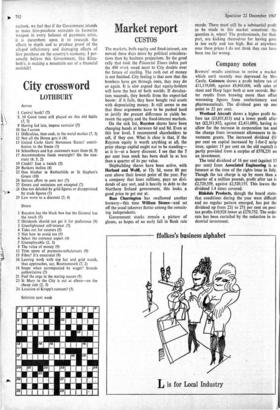Market report
CUSTOS
The markets, both equity and fixed-interest, are moved these days more by political considera- tions than by business projections. So the good rally that took the Financial Times index past the 400 mark owed most to City doubts over the future of sterling. The rush out of money is not finished. City feeling is that now that the bombers have got through once, they may do so again. It is also argued that equity-holders will have the best of both worlds. If devalua- tion succeeds, they benefit from the export-led boom: if it fails, they have bought real assets with depreciating money. It still seems to me that these arguments have to be pushed hard to justify the present difference in yields be- tween the equity and the fixed-interest markets.
On the sick list, Royston shares have been changing hands at between 6d and 8d. Even at this low level, I recommend shareholders to sell, if they can. What is clear is that, if the Royston equity is worth anything at all, the prior charge capital ought not to be standing— as it is—at a heavy discount. I see that the 7 per cent loan stock has been dealt in at less than a quarter of its par value.
Shipbuilding shares have been active, with Harland and Wolff, at 12s 3d, some 80 per cent above their lowest point of the year. For a company that loses millions, pays no divi- dends of any sort, and is heavily in debt to the Northern Ireland government, this looks _a good price to get out at.
Bass Charrington has swallowed another brewery—this time William Stones—and set off the usual takeover flutter among the remain- ing independents.
Government stocks remain a picture of gloom, as hopes of an early fall in Bank rate
recede. There must still be a substantial profit to be made in this market sometime: the question is, when? The professionals, for their part, are kicking themselves for having gone in too early and too high. But at anywhere near these prices I do not think they can have been too far wrong.


































 Previous page
Previous page